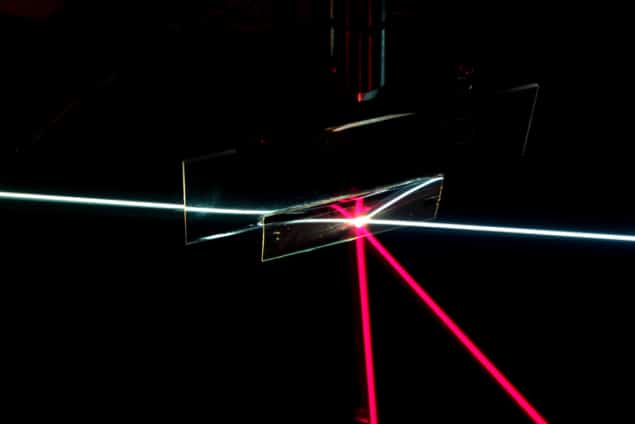
A new material that filters light according to its direction of travel has been developed by physicists in the US and China. Made of alternating layers of two different transparent materials, the structure is just 8 μm thick and offers a new and extremely simple way of controlling the direction in which light propagates. According to its inventors, the material could be used in a range of applications, from photography to solar energy.
Light, microwaves and other electromagnetic plane waves are characterized by three fundamental properties: polarization, frequency, and direction of propagation. Materials that filter light according to its polarization are commonplace, while photonic crystals can be used to select light according to its frequency. As for selecting light according to its direction of propagation, this is possible using lenses, mirrors and collimators, but miniaturizing such optical components into a practical device is difficult
Transparent, yet reflective
Yichen Shen, Marin Soljačić and colleagues at the Massachusetts Institute of Technology and Zhejiang University have now got round this problem by creating a layered material that is transparent to light incident at a specific angle, but reflects light coming in at all other angles. The operation of the device relies on the fact that light at a specific angle of incidence is transmitted completely through a transparent material. Known as “Brewster’s angle”, it is related to the ratio of refractive indices of the material and the surrounding media.
When light is incident at a different angle, some – but not all – of it will be reflected, and to increase the amount of light that bounces off the material the team created alternating layers of materials with two different indices of refraction. If the separation between layers of similar material is one quarter the wavelength of the light, light reflected from successive layers interferes constructively and nearly all of the light incident at angles other than Brewster’s is reflected.
Nice one, Brewster
While Brewster’s angle does not depend on the wavelength of the light, the constructive interference does vary with that value. To make the device work over a broad spectrum of wavelengths, the team systematically varied the thicknesses of the layers from 70 to 150 nm. The device was created by sputtering 84 alternating layers of silica and tantalum oxide onto a silica substrate. The resulting angular filter is 8 μm thick and has an area of 2 × 4 cm.
The material was then tested while immersed in water, which is necessary because the liquid has the same refractive index as silica. The team fired beams of light at the filter and measured the amount of light transmitted through the filter as a function of the incident angle. They found nearly about 90% transmission for light that falls within 8° of Brewster’s angle, which in this case was 55°. At all other angles, nearly all of the light is reflected and the device functioned in this way over a range of wavelengths, from about 450–700 nm.
Solar cells and filters
Shen and Soljačić told physicsworld.com that one possible application of the filter is in thermal solar-energy systems, which convert sunlight into heat that is then harvested to create electricity. A major problem with these systems is that they tend to radiate infrared light as they heat up, leading to a drop in efficiency. Such devices could be covered in an angular filter that lets the parallel rays of the Sun through but prevents most of the infrared light – which is emitted in random directions – from escaping.
Another possible application, according to the scientists, is camera filters that would only admit light coming directly from the subject and reject light from background sources such as the sky. This could also be particularly useful for both optical and radio astronomy because similar structures could be built to operate at radio and microwave frequencies.
The angular filter is described in Science.



